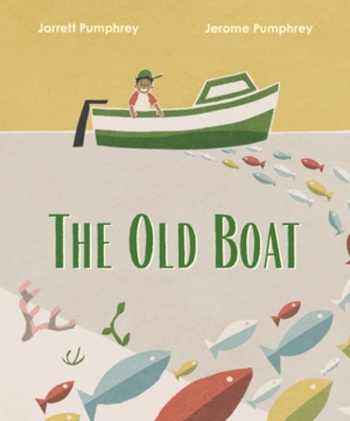Brothers Jarrett and Jerome Pumphrey (side note: have there ever been sibling Caldecott co-winners?) follow up last year’s sleeper favorite The Old Truck with The Old Boat, another emotionally moving story about a vehicle and its family.
 Brothers Jarrett and Jerome Pumphrey follow up last year’s sleeper favorite The Old Truck (a mock Calling Caldecott honor book!) with The Old Boat, another emotionally moving story about a vehicle and its family. Before the title page, a young boy walks toward an adult standing at a green-and-white fishing vessel. With their big smiles reflecting the anticipation of time spent together, they set off from their island home.
Brothers Jarrett and Jerome Pumphrey follow up last year’s sleeper favorite The Old Truck (a mock Calling Caldecott honor book!) with The Old Boat, another emotionally moving story about a vehicle and its family. Before the title page, a young boy walks toward an adult standing at a green-and-white fishing vessel. With their big smiles reflecting the anticipation of time spent together, they set off from their island home.
After a title page that spotlights the modest craft, the human characters are shown aboard, line cast, and with a bevy of colorful sea creatures below. A page-turn brings a similar scene — but with key differences. Instead of fish, turtles, crustaceans, and coral in plenty of clean, open water, we see a trash bag, a tire, some bottles, etc. Gone are the characters’ smiles … and, wait, weren’t they wearing different clothes? The changes are subtle, but every page-turn brings slightly different shirts or hats, different sea creatures or trash. Time is passing, offstage, and soon the child on the boat is taller than the adult. And then, midway through, the young person (now bearded) is shown fishing alone. And then, frighteningly, he loses his way.
The text throughout is spare and stays with the boat’s perspective: “Far from home, the old boat was cold / and lonely / and lost.” Of course, this is also the humans' experience, reminding readers of their emotional ties. The young man makes it back, injured but safe, but the boat’s damage is too great, and it’s shown offshore, sunk into the sea.
Phew. It’s an emotional punch (and perhaps a stand-in for the death of the older companion). But there’s nothing morbid or depressing about the art. The exquisite compositions keep viewers afloat. As Roger notes in his Magazine review, “the book pins the boat to the same spot on almost every spread, allowing the passing time and scene to move around it, providing a strong—anchoring—image of resilience.” Most illustrations include the constants of sea (above and below) and land, with varied configurations reflecting shifts in the rhythms of nature and of visual perspectives, but always in balance. Curved lines recall the water’s perpetual motion. Sometimes we see broken patterns — land isn’t visible, jagged lightning rips the sky, water overtakes the horizon line — and that is when the boat becomes unmoored (from its place on the right-hand pages) and sinks (now it’s on the left).
Cool, right? Reassuringly, the illustrations’ subdued palette helps keep our natural fears — life and death; change and unpredictability — at bay. Losing the boat leads the main character ashore. He stays to clean up the island, and he is eventually surrounded by others and no longer alone. While diving for trash, he even has “a moment” with the boat — now covered with plants and supporting its own ecosystem. He ends the book an old man fishing from shore alongside a little girl — bringing this memorable, ecologically minded tale full-circle.
The outpouring of love for this book’s predecessor may be on committee members’ minds. Happily for the Pumphreys (side note: have there ever been sibling co-winners? Too cute!), The Old Boat is a perfect Caldecott-committee book. This is not a story you can skim through once and “get.” It doesn’t spell out its ideas, messages, or events to readers. “Delineation of plot, theme, characters, setting, mood or information through the pictures” suits this title to a T. Visual subtleties and nuance necessitate making comparisons and drawing inferences, page-by-page and overall. Read, re-read, look again, process, and contemplate: this type of repeated close reading is required of, and a pleasure for, the Caldecott committee.
![]()
ALREADY A SUBSCRIBER? LOG IN
We are currently offering this content for free. Sign up now to activate your personal profile, where you can save articles for future viewing.








Add Comment :-
Be the first reader to comment.
Comment Policy:
Comment should not be empty !!!